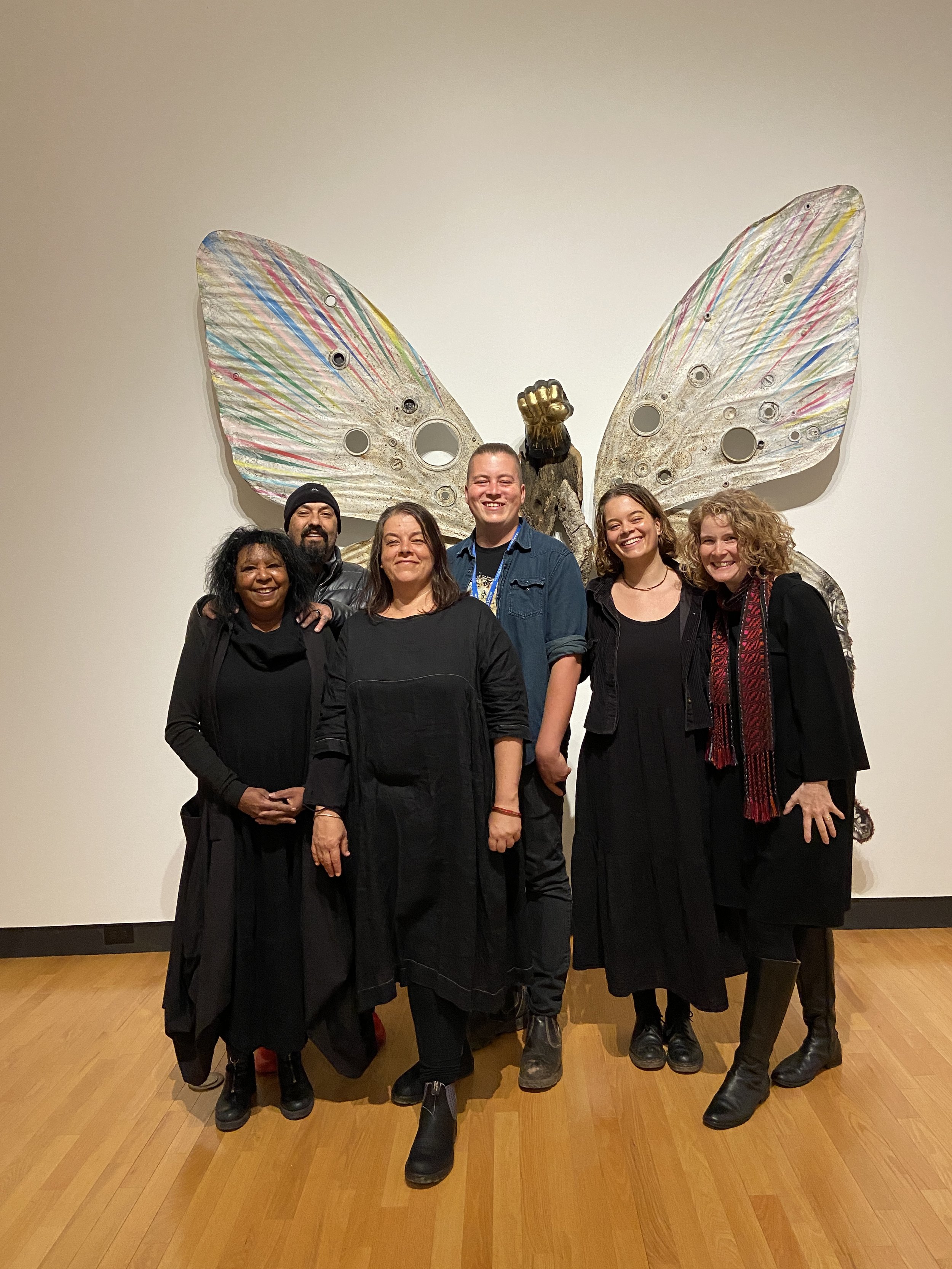By Lucy Oster ’23
Staff Writer
Photo courtesy of Ellen Alvord ‘89
At “Ancestral Memories: Artists in Conversation,” a team of Indigenous Australian artists stand in front of a sculpture by Hector Dionico Mendoza
The Mount Holyoke College Art Museum, in collaboration with the University of Melbourne and a team of Indigenous Australian artists, hosted an event on Thursday, April 7, called “Ancestral Memories: Artists in Conversation.”
The artists, Maree Clarke (Mutti Mutti/Wamba Wamba/Yorta Yorta/Boonwurrung), Nicholas Hovington (Palawa), Kerri Clarke (Boonwurrung/Wemba Wemba), Mitch Mahoney (Boonwurrung/Wemba Wemba/Barkindji) and Molly Mahoney (Boonwurrung/Wemba Wemba/Barkindji), are currently in residence at Mount Holyoke as a part of Assistant Professor of Anthropology Sabra Thorner’s “Special Topics in Anthropology: Decolonizing Museums” seminar. The class has been focusing on centering Indigenous knowledge practices and art making over a more colonial lens.
Associate Curator of Visual and Material Culture and Native American Graves Protection and Repatriation Act Coordinator Aaron Miller and Thorner opened the Ancestral Memories event. Thorner gave an updated version of the usual Mount Holyoke College land acknowledgment, urging audience members to understand the history of the Nonotuck land that the College is situated on.
“I encourage all of you to learn about and to amplify the contemporary work of the Indigenous nations whose land you’re on, and also endeavor to support Indigenous sovereignty in all the ways that you can,” she said.
Thorner also connected her land acknowledgment to the artists. “Your engagement with and your witnessing of the work of these artists is part of that process, so I extend my gratitude to you for coming here today,” she said.
“My own use of my own land acknowledgment is going rogue, right? I used my own because I feel like it’s more meaningful and more impactful and more accurate and more thoughtful than the one that is being presented to us to offer up as the official body of the College,” Thorner later shared.
After Thorner’s statement, Maree Clarke, one of the visiting artists, took over. Maree Clarke gave a presentation about her work as an artist reviving cultural practices in Southeastern Australia. She described herself as an “independent multidisciplinary artist and curator with more than 30 years working with First Nations people.” She spoke about Aboriginal art practices and how they are connected to country, culture and place, and shared stories about taking the teeth out of kangaroo roadkill to make necklaces.
“[Maree Clarke] described the PowerPoint she presented as her life’s work. … It was going through everything she had done artistically and it was really cool to see how it had changed over the years, but also how she had gotten more influence from her family,” Domenica Guaman ’22, an anthropology and Spanish major who attended the event, said. Guaman is also a student in Thorner’s seminar.
Ellen Alvord ’89, the associate director for engagement and Weatherbie curator of academic programs, shared a similar sentiment to Guaman.
“Understanding the scope of what [Maree Clarke has] done in her lifetime, to bring those practices back in her research, and in her connection with her family, and bringing in new generations to take up that practice — I thought that was really inspiring,” she said.
Much of Maree Clarke’s presentation heavily involved her family, who were also present at the Ancestral Memories event. They sat at a table next to where Maree Clarke presented, acting as a panel for the question and answer session that followed Maree Clarke’s presentation.
Erin Foley ’24, an anthropology and political science major who attended the event, said, “It was … really cool to see a multigenerational family working together collectively as artists.” Foley asked a question during the question and answer session about how their community has changed over the years, to which Kerri Clarke mentioned feeling “secure” in passing on cultural practices to the younger members of the family, Mitch and Molly Mahoney.
The final product of Thorner’s “Special Topics in Anthropology: Decolonizing Museums” seminar is a collaboratively-made possum skin cloak as a form of Indigenous knowledge transmission. The visiting artists are at Mount Holyoke, guiding and teaching the students in that class how to make the cloak. The cloak is not yet complete, but the MHCAM is looking to acquire it once it is.
“We are planning on putting the work into a show for the fall that focuses on some broad themes and conversations around indigeneity,” Miller said.
“The cloak and the conversation about the project on campus and the work that [Maree Clarke] and her family are doing: that’s going to be one conversation in a broader exhibition. Thinking about place, thinking about how objects end up in museums and then go home again. This is about reclaiming traditional ways and sharing those with communities,” Miller added.
Community was a common theme at the event. “I think that for me, [the event] really became about not only having the artists speak to and reach a broader audience in this bigger context of decolonizing museums,” Thorner said. “It also became about a kind of mission for me, to be like, ‘this has been so hard. I am going to stand up and thank everyone.’ And part of that is about forging community. This is hard, we’re in a hard moment, but it can be done. And it is so necessary to be in community and in solidarity with each other.”
Alvord concluded, “There’s just so much meaning, and so to think about having Mount Holyoke students be a part of that process, and have something involved in storytelling that’s meaningful in this moment, to that group, is really exciting.”

